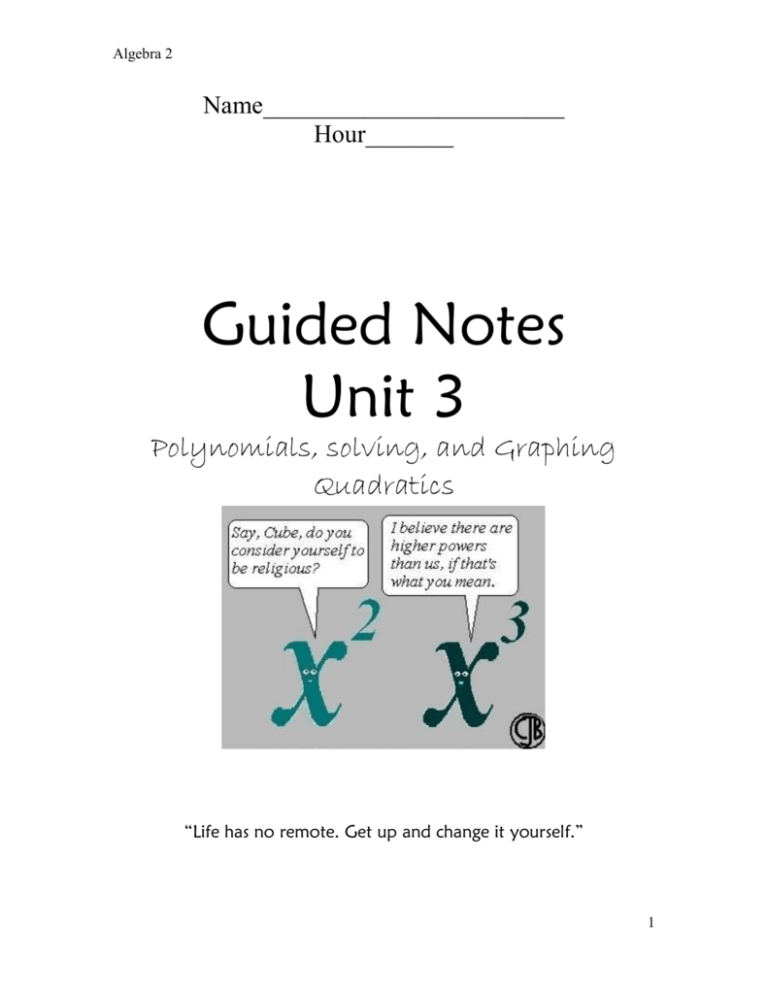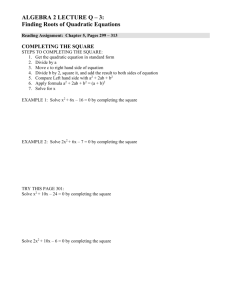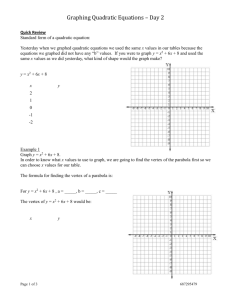Graphing with Vertex Form
advertisement

Algebra 2 Name________________________ Hour_______ Guided Notes Unit 3 Polynomials, solving, and Graphing Quadratics “Life has no remote. Get up and change it yourself.” 1 Algebra 2 Algebra 2 Unit 3 # 1 2 3 4 5 6 7 8 9 10 Learning Goal: Students will factor polynomials and solve quadratic equations using various methods including factoring, completing the square, and the quadratic formula, as well as graph quadratic functions that are represent by all three formats—vertex form, intercept form, and general form. 0 1 2 3 4 Objective in words Students will be able to identify the degree and leading coefficient of a polynomials as well as name the polynomial. Students will be able to factor basic polynomials. Students will be able to factor more complex polynomials. Students will be able to solve quadratic equations by factoring. Students will be able to solve quadratic equations by completing the square. Students will be able to solve quadratic equations using the quadratic formula. Students will be able to convert between different forms of a quadratic function— vertex, general, and intercept. Students will be able to graph quadratic functions in vertex form and identify the vertex and axis of symmetry. Students will be able to graph quadratic functions in general form and identify the vertex and axis of symmetry. Students will be able to graph quadratic functions in intercept for and identify the vertex and axis of symmetry. Score 4 Score 3 Score 2 Score 1 Score 0 I can accurately solve problems related to quadratic functions, including factoring and graphing, and identify key properties and procedures for doing so, never making a mistake. I can also apply quadratics to application and real world problems. I can accurately solve problems related to quadratic functions, including factoring and graphing, and identify key properties and procedures for doing so, rarely making a mistake. I understand and can solve basic quadratic problems, but have trouble identifying and remembering all of the procedures and properties related to quadratics. With help, I can solve these problems as long as they are not too complex. Even if I have help, I cannot do these problems….YET! 2 Algebra 2 3.1 Polynomials and Basic Factoring VOCABULARY DEFINITION EXAMPLE Monomial A number, variable or the product of a number and variable(s) with whole number exponents. 10 3x -1.8ab2 10 degree: zero 3x degree: one -1.8ab2 degree: three Degree of a Monomial The sum of the exponents of the variables in the monomial. Polynomial A sum of monomials, each is called a term. 2x3+x2+7 Degree of a Polynomial The greatest degree of its monomial terms. 2x3+x2+7 degree: three Leading Coefficient When a polynomial is written so that the exponents of a variable decrease from left to right, the coefficient of the first tem is called the leading coefficient. 2x3+x2+7 Leading coefficient: 2 POLYNOMIAL Monomial Binomial Trinomial 1) Fill in the table: Expression Is it a polynomial? 9 Y or N Classify by degree and number of terms Degree: # of terms: 2x2 + x - 5 Y or N Degree: # of terms: 6n4 - 8n Y or N Degree: # of terms: n-2 + 3 Y or N Degree: # of terms: 7bc3 + 4b4c Y or N Degree: # of terms: 3 Algebra 2 Rearrange the polynomial so the exponents are in descending order (standard form). Then identify the degree and the leading coefficient. 2) 5𝑦 − 2𝑦 4 + 9 3) 15𝑥 + 3 − 𝑥 3 4) 3𝑥 2 𝑦 3 + 2𝑥 − 7𝑥𝑦 3 THE FIRST STEP IN FACTORING SHOULD ALWAYS BE TO CHECK TO SEE IF THERE IS A GREATEST COMMON MONOMIAL FACTOR THAT CAN BE FACTORED OUT!!! Factor out the greatest common monomial. 5) 12𝑥 + 42𝑦 6) 4𝑥 4 + 24𝑥 3 7) 7𝑤 5 − 35𝑤 2 + 𝑤 Factor the binomials. Difference of Two Squares Pattern a2 – b2 = Example_____________________________________ 8) 𝑦 2 − 16 9) 25𝑚2 − 36 10) 4𝑦 2 − 64 11) 𝑥 2 − 49𝑦 2 12) 𝑥 2 − 81𝑦 2 13) 64𝑐 2 − 16 4 Algebra 2 14) 400 − 49𝑣 2 15) 8𝑥 2 − 162 Factor the following trinomials. 16) 𝑥 2 + 11𝑥 + 18 17) 𝑥 2 − 5𝑥 + 6 18) 𝑦 2 + 2𝑦 − 15 19) 𝑚2 + 𝑚 − 20 20) 𝑡 2 + 9𝑡 + 14 21) 𝑤 2 + 18𝑤 + 56 Summary 5 Algebra 2 3.2 Factoring ax2 + bx + c Factor the following trinomials. 1) 4𝑥 2 + 16𝑥 + 15 Step 1: Find ac and b. ac=____________ b=____________ Step 2: Find two numbers that multiply to ac and add to b. _______ x ________= ac ________+________=b Step 3: Split the middle bx term using the two numbers found in step 2. Step 4: Factor by grouping the first two terms and the second two terms, taking out the greatest common monomial factor from each. *Check to see what is in the parentheses matches. Answer ____________________________ Try these: 2) 2𝑥 2 − 7𝑥 + 3 3) 3𝑛2 + 14𝑛 − 5 4) −4𝑥 2 + 12𝑥 + 7 5) −𝑥 2 + 𝑥 + 20 6 Algebra 2 6) −2𝑦 2 − 5𝑦 − 3 7) 3𝑥 2 − 𝑥 − 2 Notice that this method still works when a=1. TRY: 8) 𝑛2 − 6𝑛 + 8 Factor completely. First, __________________________________________________________. 9) 4𝑥 3 − 44𝑥 2 + 96𝑥 10) 50ℎ4 − 2ℎ2 11) 3𝑥 2 − 12𝑥 12) 2𝑦 3 − 12𝑦 2 + 18𝑦 13) 2𝑎4 + 21𝑎3 + 49𝑎2 7 Algebra 2 14) You have a metal plate that you have drilled a hole into. The entire area enclosed by the metal plate is given by 5𝑥 2 + 12𝑥 + 10 and the area of the hole is given by 𝑥 2 + 2. Write an expression for the area in factored form of the plate that is left after the hole is drilled. Summary 3.3 Forms of a Quadratic Equation and Solving Equations Zero Product property _______________________________________________ ____________________________________________________________________ Solutions to a quadratic equations can be called ___________________ or ________________ or__________________ 3 Forms of a Quadratic Equation General Form Vertex Form Intercept Form 8 Algebra 2 State the zeros/roots of the graph. Find the zeros of the equations in Intercept Form (Already factored). 1) 𝑦 = (𝑥 − 4)(𝑥 + 2) 2) 𝑦 = 5(𝑥 − 5)(𝑥 − 1) 3) 𝑦 = 2𝑥(𝑥 + 7)(3𝑥 − 2) Find the zeros of the equations in Vertex Form. You solve these by taking square roots. Remember when you solve an equation by taking a square root you need_________. This is because if you think about 𝑥 2 = 4, there are two possible solutions for x, ___ & ___ 4) 𝑦 = 2(𝑥 − 3)2 − 18 5) 𝑦 = 3𝑥 2 − 48 6) 𝑦 = −2(𝑥 + 4)2 + 10 Solve equations in General Form. When solving these, don’t forget: You need to make sure the equation equals _______________. You need to _______________________________ if it is in general form. Solve the following. 7) 2𝑥 2 + 8𝑥 = 0 8) 5𝑛2 = 15𝑛 9 Algebra 2 9) 3𝑠 2 − 9𝑠 = 0 10) 4𝑠 2 = −14𝑠 11) 𝑛2 − 7𝑛 − 30 = 0 12) 𝑥 2 = 9𝑥 − 20 13) 𝑥 2 − 11𝑥 + 24 = 0 14) 𝑦 2 + 3𝑥 = 18 Find the zeros or solve. 15) 𝑦 = 3𝑥 2 − 15𝑥 + 18 Solve or find the zeros. 17) 3𝑛2 + 13𝑛 + 4 = 0 16) 𝑦 = 2𝑥 2 + 7𝑥 − 15 18) 𝑦 = 2𝑥 2 − 7𝑥 + 3 10 Algebra 2 Solve or find the zeros/roots of the following equations. 19) 3𝑥 3 + 18𝑥 2 = −24𝑥 20) 𝑦 = 8𝑥 2 + 36𝑥 + 16 21) 𝑐 4 − 64𝑐 2 = 0 22) z 3 = 4z 23) 3𝑛2 = 40 + 19𝑛 24) 2𝑥 2 − 12𝑥 − 18 = −4 25) −2𝑟 2 − 11𝑟 − 18 = −4𝑟 2 − 3𝑟 + 6 26) −11 − 7𝑘 = −7𝑘 − 𝑘 2 − 7 11 Algebra 2 Application Problems: 27) A ball is tossed into the air from a height of 8 feet with an initial velocity of 8 feet per second. Find the time t (in seconds) it take for the object to reach the ground by solving the equation −16𝑡 2 + 8𝑡 + 8 = 0 28) Students found that by launching a water ballooons 42 feet per second at a precise angle, they sould hit the statue as shown below. Here’s the equation they worked out to represent the path of the balloons: H(t) = -3t2 + 42t + 58. The t represents the number of seconds and H is the height of the balloon in feet. a) If the statue is 13 feet tall, how many seconds did it take for the balloon to reach the statue after the launch? Summary 12 Algebra 2 3.4 Completing the Square to Solve Quadratics Vocabulary: To complete the square, you wish to turn the expression into a perfect square trinomial (Like 𝑥 2 − 20𝑥 + 100 because this factors into (𝑥 − 10)2) o To complete the square for the expression x2 + bx, add ________. Because….. Finding c: Find the value of c that makes the expression a perfect square trinomial. Then write the expression as the square of a binomial. 1. x2 + 6x + c 2. x2 – 24x + c Solve by Completing the Square: Solve the equation by completing the square. Notice, YOU CANNOT factor these like we did in earlier solving problems. o Step 1: Move over the constant “c” term if needed. 𝑏 2 o Step 2: Find (2) and add to each side. o Step 3: Write the expression as the square of a binomial. o Step 4: Solve the equation using the square root method. 3. x2 + 4x = 10 4. x2 + 8x + 1 = 0 13 Algebra 2 5. x2 – 10x +13 = 0 Solve by Completing the Square with a other than 1: 6. 3x2 + 6x = 72 Old Method: 7.8𝑥 2 + 16𝑥 = 42 14 Algebra 2 Rewriting the forms of a quadratic: 8. Write y = x2 – 10x + 22 in vertex form. 9. The height, h, in feet of a baseball t seconds after it is hit is given by: h = -16t2 + 96t +3. Rewrite in vertex form. a) What is the vertex (maximum height of ball)? 10. Given 𝑦 = 2(𝑥 − 1)2 + 7, rewrite into general form. Summary 15 Algebra 2 3.5 Using the Quadratic Formula Solve Quadratics Vocabulary: The quadratic formula is _______________________________ IF ALL ELSE FAILS, THE QUADRATIC FORMULA CAN ALWAYS BE USED TO SOLVE A QUADRATIC EQUATION. Solve the following quadratic equations using the quadratic formula. Step 1: Set equation equal to zero Step 2: Identify a, b, and c. Step 3: Plug a, b. and c into the quadratic formula Step 4: Simplify to get answer(s) 1) 3𝑥 2 + 5𝑥 = 8 2) 𝑥 2 − 8 = −7𝑥 3) 2𝑥 2 − 𝑥 − 7 = 0 16 Algebra 2 4) 𝑥 2 + 7𝑥 + 5 = 0 Solve the following quadratic using all three methods below: 𝑥 2 − 2𝑥 − 3 = 0 Factoring: Completing the Square: Quadratic formula: Summary 17 Algebra 2 3.6 Graphing in Vertex Form VERTEX FORM Quadratic Functions: Parabolas (Identify Key Characteristics) Minimum or Maximum? The value of a decides if it is max or min. If a>0, then the graph opens _____________ and has a ____________ If a<0, then the graph opens _____________ and has a ____________ Graphing with Vertex Form: Graph the Function. Identify the domain and range. 1. y = 3(x – 4)2 - 3 Steps to graph in vertex form. 1. Identify the constants: a= h= k= 2. Plot (h, k) and draw in A of S. 3. Then evaluate the function for two other x values near the A of S and reflect to other side of A of S. **Remember: You need 5 points, vertex and two on each side 18 Algebra 2 2. Graph y = -(x – 1)2 + 5 𝟏 3. Graph y = -𝟐(x + 3)2 Writing an Equation for a Graph 4. Write an equation for this graph in vertex form. 5. Write an equation for this graph in vertex form. 19 Algebra 2 6. Write the general form of the equation into vertex form. Recall to do this we ____________ _______ __________. 𝑦 = 2𝑥 2 + 12𝑥 − 4 Summary 20 Algebra 2 3.7 Graphing in General Form GENERAL FORM Graphing with General Form: Graph the function. Identify the domain and range. Steps to graph standard quadratic functions. 1. y = 5x2 + 1 1. Identify the coefficients: a= b= c= 2. Find the axis of symmetry (A of S) using: b x 2a 3. Draw the axis of symmetry: x = 4. Find the vertex plugging in the x from step 3 to find y. 5. Identify the y-intercept: (0, c) and reflect this point if possible. 6. Evaluate the function for other value(s) of x near A of S. Plot these points, and reflect it to other side of A of S. **Remember: You need 5 points, vertex and two on each side 21 Algebra 2 2. y = 3x2 4. Graph y = -x2 – 5 3. y = x2 + 2x + 1 5. Graph y = 2x2 + 12x + 9 22 Algebra 2 6) A rocket is launched from 180 feet above the ground at time t=0. The function that models this situation is given by h(t)= - 16t2 + 96t + 180, where t is measures in seconds and h is the height above the ground measured in feet. a) Determine the height of the rocket two seconds after it was launched. b) Determine the time the rocket reaches its maximum height and the maximum height obtained by the rocket. (Hint: Think about the vertex) Summary 23 Algebra 2 3.8 Graphing in Intercept Form INTERCEPT FORM Graphing with Intercept Form: Graph the function. Identify the domain and range. 1. y = (x + 2)(x – 3) Steps to graph in intercept form. 1. Identify the x-intercepts: p= q= 2. Find the A of S using: pq x 2 3. Plot the vertex using x above and plugging in the x to find y. 4. Evaluate the function at one other x-value and reflect this point using the A of S. **Remember: You need 5 points, vertex and two on each side 2. Graph y = 2(x + 2)(x –2) 24 Algebra 2 3. Graph y = -(x + 1)(x – 5) 4. Graph y = (x – 3)(x – 7) 5. Take the above equation in #3, y = -(x + 1)(x – 5), and rewrite it in general form. a) Show using 𝑥 = −𝑏 2𝑎 for the general form above, that you get the same A of S. Summary 25









